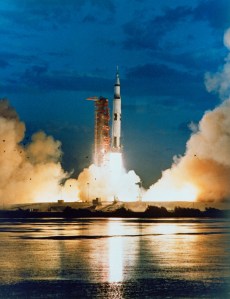After the very successful first test of the Saturn 5 and Command and Service Module (CSM) during Apollo 4, and the equally successful first flight of the Lunar Module (LM) during Apollo 5, NASA was preparing to fly the Saturn 5 on a second unmanned test flight that if successful might pave the way for a manned flight of the giant Moon rocket. Apollo 6, the second all-up test, would test all three stages of the Saturn 5 and include re-ignition of the third stage to simulate a Trans-Lunar Injection, to place the CSM in a highly elliptical Earth orbit. The Service Module engine would then be tested by first firing in a retrograde direction to simulate a direct return abort scenario. It would be fired a second time to increase the Command Module’s speed at reentry to test the all-important heat shield at lunar reentry speeds. Stacking of the Saturn 5 booster in the Kennedy Space Center’s Vehicle Assembly Building (VAB) began on March 29, 1967, and was completed with the installation of the Apollo spacecraft on December 10. No active LM was carried on this flight, replaced instead with the LM Test Article (LTA) 2R to partially simulate its mass in order to approximate structural loads on the rocket during launch.
On February 6, 1968, just two weeks after Apollo 5 completed its mission, the Saturn 5 rocket and Apollo 6 spacecraft atop the Mobile Launch Platform began its 8-hour, 3.5-mile trip from the VAB to Launch Pad 39A. Once on the pad, NASA engineers conducted several weeks of testing on the vehicle including the all-important Count Down Demonstration Test completed in late March. Apollo 6 flew its 10-hour test flight on April 4, and despite encountering several technical issues paved the way for future missions that achieved President John F. Kennedy’s goal of “landing a man on the Moon and returning him safely to the Earth” before the end of the decade.


































